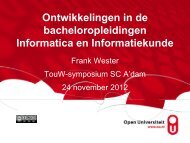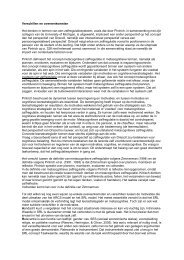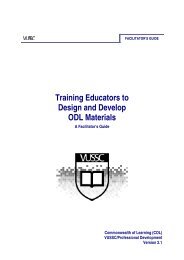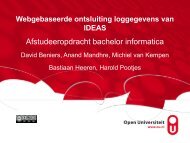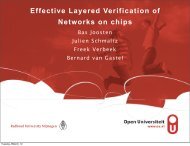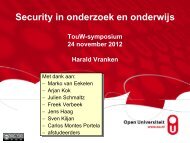MIT STEP/TEA
MIT STEP/TEA
MIT STEP/TEA
- No tags were found...
You also want an ePaper? Increase the reach of your titles
YUMPU automatically turns print PDFs into web optimized ePapers that Google loves.
Mobile Media Consumers<strong>MIT</strong> <strong>STEP</strong>/<strong>TEA</strong> 5
Creative Play<strong>MIT</strong> <strong>STEP</strong>/<strong>TEA</strong> 8
Creative Invention<strong>MIT</strong> <strong>STEP</strong>/<strong>TEA</strong> 9
Mobile Design Affordances• Portability• Social Interactivity• Context Sensitivity• Connectivity• Individuality<strong>MIT</strong> <strong>STEP</strong>/<strong>TEA</strong> 10
Creative Play & STEM Games• Computer simulations and games– let learners interact with naturalsystems that cannot be observed– motivate learners with challengesand give rapid feedback– tailor instruction to individuallearners’ needs and interests• (NRC report (2011): Learning ScienceThrough Computer Games and Simulations)<strong>MIT</strong> <strong>STEP</strong>/<strong>TEA</strong> 11
Games? Learning? How many volts doI need for my lasercanon to kill 3 x 6opponents?<strong>MIT</strong> <strong>STEP</strong>/<strong>TEA</strong> 12
The Legacy of Math Blaster• Edutainment– Where play is the reward forlearning<strong>MIT</strong> <strong>STEP</strong>/<strong>TEA</strong> 13
The Legacy of Math Blaster• Edutainment– Gets kids to eat broccoli– But doesn’t promote healthyeating (learning)– What happens when thechocolate goes away?<strong>MIT</strong> <strong>STEP</strong>/<strong>TEA</strong> 14
The Legacy of Math Blaster– Instead learning should be playful<strong>MIT</strong> <strong>STEP</strong>/<strong>TEA</strong> 15
Where and When to Play?• Anytime and Anywhere• Here and Now<strong>MIT</strong> <strong>STEP</strong>/<strong>TEA</strong> 16
Anytime Anywhere – The Ecology of School<strong>MIT</strong> <strong>STEP</strong>/<strong>TEA</strong> 17
Mobile Social Games<strong>MIT</strong> <strong>STEP</strong>/<strong>TEA</strong> 18
UbiqGames• Designed for the Mobile Web• Paced to encourage short andfrequent game play• Played in the “interstitial” spacesin school• Connected to specific classlearning goals through curriculum<strong>MIT</strong> <strong>STEP</strong>/<strong>TEA</strong> 19
Weatherlings• Data snapshot– Who and When<strong>MIT</strong> <strong>STEP</strong>/<strong>TEA</strong> 21
UbiqBio<strong>MIT</strong> <strong>STEP</strong>/<strong>TEA</strong> 22
Responsive Design<strong>MIT</strong> <strong>STEP</strong>/<strong>TEA</strong> 23
Teacher/Researcher Portal• Teachers• create class rosters• observe game play• track student progress• Researchers• log game play patterns• collect student data<strong>MIT</strong> <strong>STEP</strong>/<strong>TEA</strong> 24
Game Play by Gender400 Male vs. Female Gameplay by Game 350 300 Mintes Played 250 200 150 Male Female 100 50 0 BB* Beas-es Island Hoppers Chomp!** Game <strong>MIT</strong> <strong>STEP</strong>/<strong>TEA</strong> 25
Game Impact on Test Scores6 Control vs Experimental Quiz Scores by Game 5 Quiz Subscore 4 3 2 Control Mean Experimental Mean 1 0 * Gene-cs Evolu-on DNA Ecology Game/Topic Area <strong>MIT</strong> <strong>STEP</strong>/<strong>TEA</strong> 26
Leveling Up?• How is score on each section impacted by…– Time spent playing– Levels completedGeneBcs DNA EvoluBon Ecology Time (10K) -‐.039 .0647 -‐ .223 x Level .245 x .0138 x ???<strong>MIT</strong> <strong>STEP</strong>/<strong>TEA</strong> 27
Do Games Work?• Not all games are the same40 35 30 25 20 15 DifficultyA DifficultyB Difficulty C 10 5 0 1 2 3 4 5 6 7 <strong>MIT</strong> <strong>STEP</strong>/<strong>TEA</strong> 28
What Makes Games Work?GeneBcs DNA EvoluBon Ecology Time (10K) -‐.039 .0647 -‐ .223 x Level .245 x .0138 x 40 35 30 25 20 15 DifficultyA DifficultyB Difficulty C 10 5 0 1 2 3 4 5 6 7 <strong>MIT</strong> <strong>STEP</strong>/<strong>TEA</strong> 29
Games as Treatments?<strong>MIT</strong> <strong>STEP</strong>/<strong>TEA</strong> 30
The Medical Model<strong>MIT</strong> <strong>STEP</strong>/<strong>TEA</strong> 31
Games as Treatments?<strong>MIT</strong> <strong>STEP</strong>/<strong>TEA</strong> 32
Here and NowAugmented RealityComputer simulation on mobile devicetriggered by real world context• Combines physical &virtual world contexts• Embeds learners inauthentic situations• Engages users in asocially facilitatedcontext<strong>MIT</strong> <strong>STEP</strong>/<strong>TEA</strong> 33
Timelab 2100 AR Example• It is the year 2100 and Climate Changehas spun out of control• Head back to 2012 to make smallchanges to the past• Location specific information – e.g.– By the river - Location is now under water– By the train station – Consider incentives toincrease use• Also includes face to face discussion<strong>MIT</strong> <strong>STEP</strong>/<strong>TEA</strong> 34
Games as Treatments?<strong>MIT</strong> <strong>STEP</strong>/<strong>TEA</strong> 35
Gaminess• What features are important to structure games?– Interesting decisions (Sid Meier)– Consequences to decisions (+/- value)– Clearly defined goals (rules/constraints)– Visible measurable feedback (quantifiable outcome)– Underlying model/system (coherent system of rules)Little GaminessLots of GaminessMoviesDollsBooksScavenger HuntThe SimsWoWRisk<strong>MIT</strong> <strong>STEP</strong>/<strong>TEA</strong> 36
Gaminess• For the <strong>MIT</strong> students…– Interesting decisions þ– Consequences to decisions (+/-) þ– Clearly defined goals þ– Visible measurable feedback ý– Underlying model/system ýLittle GaminessLots of GaminessMoviesDollsBooksScavenger HuntThe SimsWoWRisk<strong>MIT</strong> <strong>STEP</strong>/<strong>TEA</strong> 37
Gaminess• For the HS students…– Interesting decisions þ– Consequences to decisions (+/-) ý– Clearly defined goals ý– Visible measurable feedback ý– Underlying model/system ýLittle GaminessLots of GaminessMoviesDollsBooksScavenger HuntThe SimsWoWRisk<strong>MIT</strong> <strong>STEP</strong>/<strong>TEA</strong> 38
GaminessLittle GaminessLots of GaminessMoviesDollsBooksScavenger HuntThe SimsWoWRisk<strong>MIT</strong> <strong>STEP</strong>/<strong>TEA</strong> 39
The Joy of Gaming?<strong>MIT</strong> <strong>STEP</strong>/<strong>TEA</strong> 40
The Joy of Gaming<strong>MIT</strong> <strong>STEP</strong>/<strong>TEA</strong> 41
Feedback?• How can we provide more feedback?<strong>MIT</strong> <strong>STEP</strong>/<strong>TEA</strong> 42
Feedback• When should we provide feedback?– Frequency and response type<strong>MIT</strong> <strong>STEP</strong>/<strong>TEA</strong> 43
Learning Goals?• Cognitive Skills• Non-cognitive skills– Persistence– Grit• Metacognitive skills– Reflection– Abstraction<strong>MIT</strong> <strong>STEP</strong>/<strong>TEA</strong> 44
Zone of Proximal DevelopmentCan/Will Do With Help Can’t Do/ Won’t Do Can Do/ Will Do Vygotsky<strong>MIT</strong> <strong>STEP</strong>/<strong>TEA</strong> 45
Zone of Proximal DevelopmentCan/Will Do With Help Can’t Do/ Won’t Do Can Do/ Will Do <strong>MIT</strong> <strong>STEP</strong>/<strong>TEA</strong> 46
Ecology of Play and Work• A game helps structure an experience, and ideally includesopen-ended play and structure and support for learningWorkLearningStructurePlayFunOpen-endedc/o ScotOsterweil<strong>MIT</strong> <strong>STEP</strong>/<strong>TEA</strong> 47
Ecology of Play and Work• A game helps structure that experience and ideally includesopen-ended play and structure and support for learningLearning/StructureFun/Play<strong>MIT</strong> <strong>STEP</strong>/<strong>TEA</strong> 48
The Fun of StructureStructured, goal-oriented,feedback-driven can be funIn games we willingly submit to arbitraryrules and structures in pursuit of mastery,but only if we can continue to be playful.<strong>MIT</strong> <strong>STEP</strong>/<strong>TEA</strong> 49
The Fun of StructureStructured, goal-oriented,feedback-driven can be funIn games we willingly submit to arbitraryrules and structures in pursuit of mastery,but only if we can continue to be playful.<strong>MIT</strong> <strong>STEP</strong>/<strong>TEA</strong> 50
Structure is Fun<strong>MIT</strong> <strong>STEP</strong>/<strong>TEA</strong> 51
Structure is Fun<strong>MIT</strong> <strong>STEP</strong>/<strong>TEA</strong> 52
Structure is Fun<strong>MIT</strong> <strong>STEP</strong>/<strong>TEA</strong> 53
Structure is Fun<strong>MIT</strong> <strong>STEP</strong>/<strong>TEA</strong> 54
Structure is Fun<strong>MIT</strong> <strong>STEP</strong>/<strong>TEA</strong> 55
Structure is Fun<strong>MIT</strong> <strong>STEP</strong>/<strong>TEA</strong> 56
Structure is Fun<strong>MIT</strong> <strong>STEP</strong>/<strong>TEA</strong> 57
Zone of Proximal DevelopmentCan/Will Do With Help Can’t Do/ Won’t Do Can Do/ Will Do <strong>MIT</strong> <strong>STEP</strong>/<strong>TEA</strong> 58
Zone of Proximal DevelopmentCan/Will Do With Help Can’t Do/ Won’t Do Can Do/ Will Do <strong>MIT</strong> <strong>STEP</strong>/<strong>TEA</strong> 59
Creative Play and Invention<strong>MIT</strong> <strong>STEP</strong>/<strong>TEA</strong> 60
Creative Invention• Simple but “flexible” tools<strong>MIT</strong> <strong>STEP</strong>/<strong>TEA</strong> 61
TaleBlazer.org62<strong>MIT</strong> <strong>STEP</strong>/<strong>TEA</strong> 62
<strong>MIT</strong> <strong>STEP</strong>/<strong>TEA</strong> 63
Sharing<strong>MIT</strong> <strong>STEP</strong>/<strong>TEA</strong> 64
Learning Through App Creation• Apps– Personal– Meaningful/Useful– Shareable– Small and Specific<strong>MIT</strong> <strong>STEP</strong>/<strong>TEA</strong> 65
Personally Meaningful<strong>MIT</strong> <strong>STEP</strong>/<strong>TEA</strong> 66
Real Programming<strong>MIT</strong> <strong>STEP</strong>/<strong>TEA</strong> 67
<strong>MIT</strong> <strong>STEP</strong>/<strong>TEA</strong> 68
<strong>MIT</strong> <strong>STEP</strong>/<strong>TEA</strong> 69
Technovation<strong>MIT</strong> <strong>STEP</strong>/<strong>TEA</strong> 70
Environmental Science: Measuring Tree Heighthttp://notes.hfoss.org/index.php/TreeCalc:Main_Page<strong>MIT</strong> <strong>STEP</strong>/<strong>TEA</strong> 71
<strong>MIT</strong> <strong>STEP</strong>/<strong>TEA</strong> 72
App Inventor Curriculum<strong>MIT</strong> <strong>STEP</strong>/<strong>TEA</strong> 73
unx - MOOC<strong>MIT</strong> <strong>STEP</strong>/<strong>TEA</strong> 74
App Inventor Availability• Open source through<strong>MIT</strong> Center for MobileLearning• Free <strong>MIT</strong> service startedspring 2012• More to come<strong>MIT</strong> <strong>STEP</strong>/<strong>TEA</strong> 75
• Thanks to:– US Dept of Education, NSF, NIH, Google,Singapore MDA, Telefonica, CSEV, UNED,Motorola Foundation– Judy Perry, Josh Sheldon, Jason Haas,Lisa Stump, Daniel Wendel, WendyHuang, Scot Osterweil, Caitlin Feeley,Dana Tenneson, Louisa Rosenheck– <strong>STEP</strong>/<strong>TEA</strong> MEng and UROPs• @eklopfer• http://education.mit.edu• http://educationarcade.org• http://taleblazer.org• http://appinventor.mit.edu<strong>MIT</strong> <strong>STEP</strong>/<strong>TEA</strong> 76




